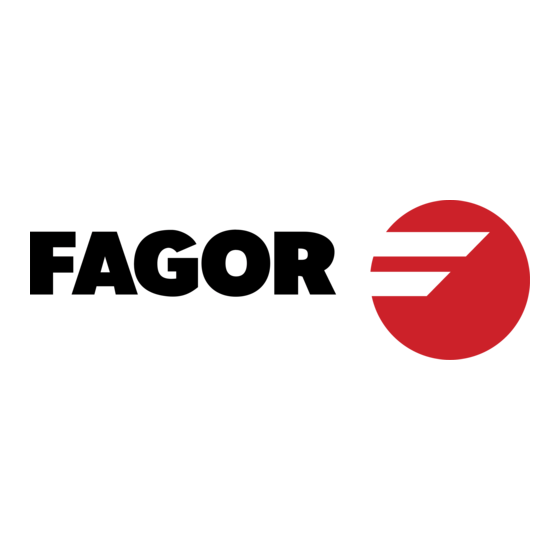
Table of Contents
Advertisement
Advertisement
Table of Contents

Summarization of Contents
Introduction
Safety Conditions
Essential safety measures to prevent personnel and product damage.
Material Returning Terms
Guidelines for packing and returning CNC units for repair or service.
Fagor Documentation for CNC Models
Information on OEM and User manuals for Fagor CNC systems.
Chapter 1: Peripherals
1.1 Front Panel Description
Description of the buttons and indicators on the CNC's front panel.
1.2 Peripheral Mode Operation
How to use the peripheral mode for data transfer via RS232C.
1.2.1 "1-OUTPUT" Option: CNC to Peripheral
Procedure for sending data from the CNC to a peripheral device.
1.2.2 "0-INPUT" Option: Peripheral to CNC
Procedure for receiving data from a peripheral device into the CNC.
Chapter 2: Aux Mode
2.1 System Input/Output Test
Analyzing status of CNC logic inputs and outputs and activating logic outputs.
2.2 Machine Parameters
Overview and access to machine parameter settings.
2.2.1 Editing Machine Parameters
Step-by-step guide to editing individual machine parameters.
2.3 Tool Table or Zero Offset Table
Accessing and managing the CNC's internal tool or zero offset table.
Chapter 3: Jog Mode
3.1 Jogging the Axes
Procedures for moving machine axes using jog controls.
3.2 Automatic Positioning
Executing programmed movements to specific coordinates.
3.3 Zero Setting and Coordinate Preset
Setting or presetting coordinate values for machine axes.
3.4 Machine Reference (Home) Search
Process for homing machine axes to establish reference points.
3.5 Operation as a DRO
Configuring the CNC to function as a Digital Readout (DRO).
Chapter 4: Program Editing
4.1 Editing Mode
Basic operations for editing part programs block by block.
4.2 Teach-In Editing
Editing programs by executing blocks and recording movements.
4.3 Play-Back Editing
Jogging axes and entering coordinates directly into program blocks.
Chapter 5: Program Execution
5.1 Program Execution
Steps for starting and running programs in different modes.
5.2 Program Interruption
Methods to pause, resume, or stop program execution.
5.3 Display Modes
Selecting and viewing different types of information on the CNC display.
5.4 Display of Arithmetic Parameters
Viewing and navigating the CNC's arithmetic parameters.
5.5 Change of Operating Mode
Switching between Automatic and Single-Block modes during program run.
Chapter 6: Programming
6.1 Programming Format
Structure and syntax rules for writing CNC part programs.
6.2 Basic Concepts
Fundamentals of block numbering, metric/inch, and absolute/incremental programming.
6.3 Reference Systems
Defining and using machine reference points and part zeros.
6.4 Complementary Functions
Explanation of F, S, T, and M functions in programming.
6.5 Path Control
Defining and controlling axis movement paths.
6.6 Additional Preparatory Functions
Functions like Dwell, Part Counter, and Corner modes.
6.7 Special Functions
Functions for feedback control and axis loop management.
6.8 Other Functions
Batch programming, probing, rigid tapping, and punch loading.
6.9 Parametric Programming
Using parameters to define variable values in program functions.
Error Codes
Error Codes List
Comprehensive list of error codes and their meanings for troubleshooting.
CNC 101/102(S) New Features
Software Version 2.02 Updates
Details on new features and changes in Software Version 2.02.
Software Version 2.03 Updates
Details on new features and changes in Software Version 2.03.














Need help?
Do you have a question about the 102S and is the answer not in the manual?
Questions and answers